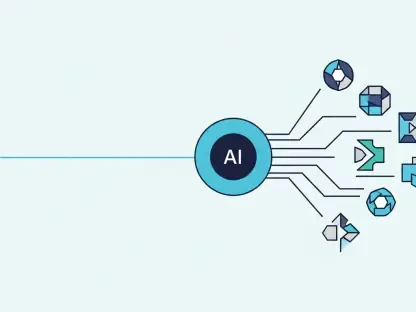In the rapidly evolving landscape of healthcare technology, the integration of artificial intelligence into radiology poses unique challenges and opportunities. Radiologists often face the task of quick decision-making based on complex medical data, and errors in recommendations can have severe consequences. Recent advancements involve employing retrieval-augmented generation (RAG) techniques to elevate the accuracy of large language models (LLMs) in radiology, particularly during consultations concerning contrast media. This innovation is pivotal in refining the reliability of AI-generated insights and protecting sensitive patient data by using local systems rather than relying on cloud-based services.
The Necessity of Reducing AI Hallucinations
Enhancing Accuracy in Radiology Consultations
One significant challenge in deploying AI within radiology is the tendency of models to produce “hallucinations,” or incorrect outputs, which can lead to dire consequences in clinical settings. In radiology, especially during contrast media consultations, decision-making is intricate. Factors such as the patient’s renal function, possible drug interactions, and allergy histories require precise inputs to formulate safe clinical judgments. Hallucinations could lead to recommendations that may not align with actual patient conditions, thereby endangering patient safety.
Japanese researchers, including notable efforts by Associate Professor Akihiko Wada and his team, have been at the forefront of utilizing RAG techniques to augment local LLMs for this purpose. By integrating RAG, a more dynamic, context-aware approach is enabled, allowing models to retrieve relevant, real-time information from trusted medical sources. This methodology significantly mitigates the risk of hallucinations, ensuring decisions are grounded in up-to-date, factual data. Tests conducted on these enhanced models, especially in cases involving iodinated contrast media, demonstrated that RAG-enhanced models successfully eliminated hallucinations, thereby enhancing the confidence and dependability of AI in healthcare decision-making.
Speed and Privacy Enhancements through Local Deployment
Beyond improvements in accuracy, the RAG-enhanced models bring substantial progress in response speed and privacy protection—two critical factors in contemporary healthcare environments. The typical response time of RAG-equipped LLMs was observed to be 2.6 seconds, markedly faster than traditional cloud-based services like GPT-4o mini and Gemini 2.0 Flash, which range from 4.9 to 7.3 seconds. This swift response capability is critical, especially in settings where time is synonymous with patient outcomes.
Privacy remains a paramount concern in medical AI applications. By deploying these RAG-enhanced models locally, healthcare facilities can significantly minimize the risk of exposing sensitive patient data to cloud infrastructures. This local deployment ensures that data remains confined within the institution, bolstering patient confidentiality. Hospitals can thus leverage AI’s benefits without compromising ethical standards concerning data privacy, an increasingly pressing consideration as regulations tighten globally.
Implications for Healthcare Ethics and Technology Integration
Balancing Technological Advancement with Ethical Considerations
The intersection of technological advancement and ethical practice in healthcare is delicately poised, and the application of RAG in radiology exemplifies this balance. Institutions today are not only looking for innovative solutions that enhance clinical outcomes but also actively prioritize privacy and equity. Deploying RAG within local systems addresses these ethical concerns by providing a robust framework where sensitive medical data is protected, and AI-assisted tools are designed to be accessible and affordable for all healthcare facilities, including those with limited resources.
The implications are far-reaching. Facilities in remote or less affluent regions can now harness advanced AI capabilities without heavy investments in expensive infrastructure or software subscriptions. This democratization of AI technology is vital in narrowing the disparity between urban and rural healthcare provisions, aligning with broader goals of equitable health access and enhancement of clinical practice standards across diverse settings.
Future Prospects for RAG in Broader Medical Applications
As RAG continues to demonstrate its utility in radiology, its potential applications extend beyond into other medical specialties, such as emergency medicine, cardiology, and internal medicine. The hallmark of RAG technology lies in its ability to pull from a vast corpus of medical knowledge—including international guidelines and institution-specific protocols—ensuring that AI recommendations are well-anchored in reality. Such adaptability and reliability are essential in fields where rapid and accurate decision-making is not just desirable but critical.
Future prospects involve further refining these models to ensure they are user-friendly, integrating seamlessly into existing hospital workflows, and providing intuitive interfaces to aid clinicians effectively. The scalability of RAG-enhanced models means that as technology progresses and more data becomes available, these systems can adapt and grow, consistently offering cutting-edge solutions to the healthcare sector’s evolving demands.
Vision for AI-Integrated Healthcare Excellence
In the ever-changing field of healthcare technology, incorporating artificial intelligence within radiology presents distinct challenges and opportunities. Radiologists often need to make rapid decisions based on intricate medical details, and mistakes in their recommendations can have serious implications. Recent progress has focused on using retrieval-augmented generation (RAG) methods to improve the accuracy of large language models (LLMs) specifically in radiology, especially during consultations involving contrast media. This advancement is crucial for enhancing the dependability of AI-generated insights. It not only aids in accuracy but also prioritizes the protection of patient privacy by implementing local systems, thereby avoiding reliance on cloud services that may pose data security risks. By integrating these cutting-edge techniques, the field aims to bolster healthcare professionals’ confidence in AI tools, ensuring better patient outcomes. Additionally, these innovations pave the way for more secure and efficient healthcare practices.









